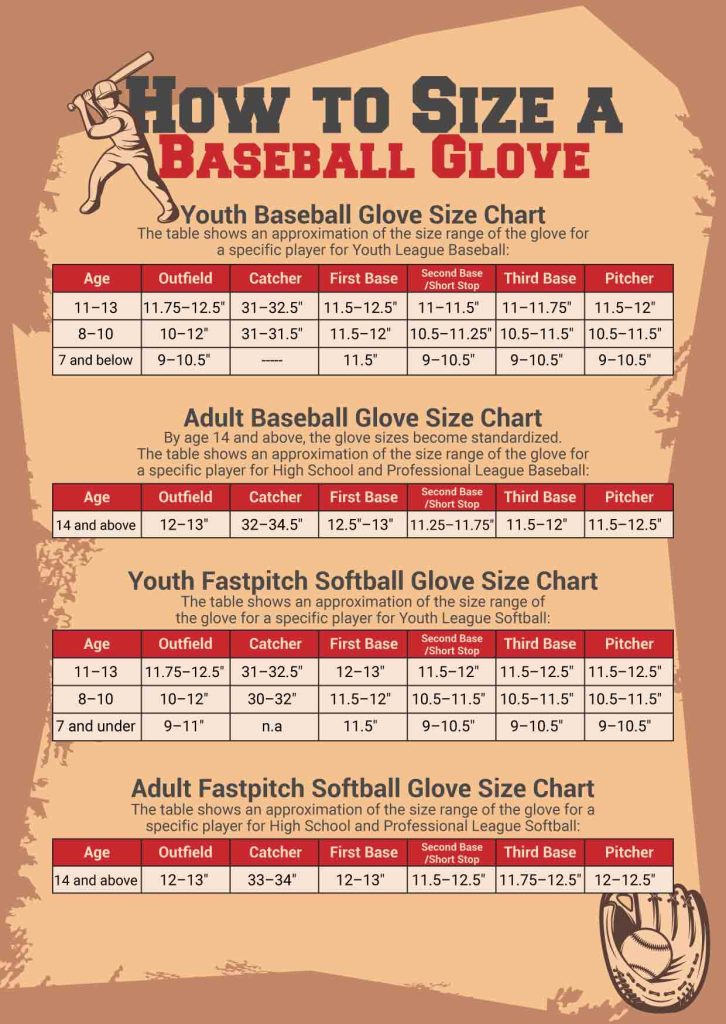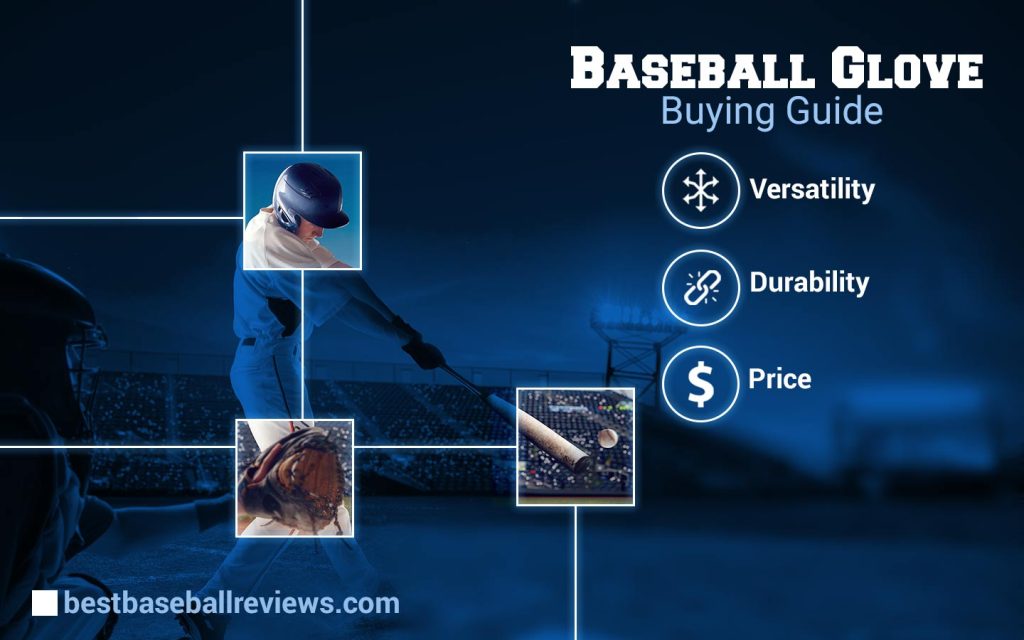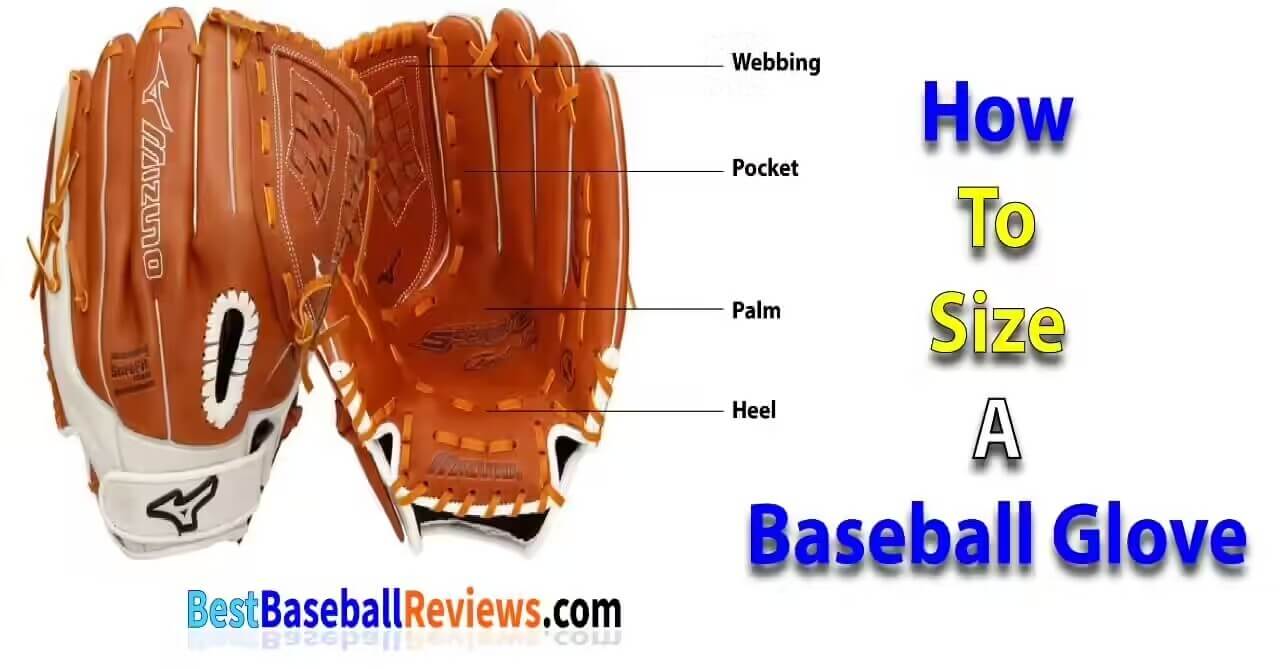How to size a baseball glove is a question all newcomers ask. You needed to answer this question unless you knew people who played the game before you. We here are here to answer this simple question and find you the best baseball gloves under 100. To understand how to measure a baseball glove size, there are some things you need to remember.
For example, what kind of baseballer you are, your age group, whether you want to play baseball or softball, and more. And after figuring out your baseball glove size, we will help you buy the best baseball glove for your 10 year old in your price range.
Now let us start by learning how to size a baseball and softball glove properly.
How to measure baseball gloves correctly
The steps on how to size a baseball glove is rather simple. First you need to get a tape measure and then measure from your dominante hand. You need to measure from the tip of your index finger to the base of the heel. The total distance in inches is the size of your baseball glove. You can match the size by checking the thumb or the pinky finger of a glove.
In general, glove sizes go from 8 inches to 15 inches. But the average for most high school leagues and the professional leagues is about 12.5 inches. The measures for a baseball catcher’s mitt can go as high as 35 inches. Again the average catcher’s mitt size for most high school leagues and the professional leagues are about 32.5 inches to 34 inches. Those 15 inches and 35 inches gloves are for outliers.
Here is an interesting fact on baseball glove size, the smallest glove size of any pro baseballer is of Elvis Andrus, shortstop of Oakland Athletics. His glove size is 11.25”.
Now you need to know how a manufacturer measure gloves for a better idea about baseball and softball glove. In fact, manufacturers use hand circumferences for glove.
Size measurements
To measure your hand circumference, you need to place your measuring instrument about two centimeters above the thumb pit, which is the shallow part of your thumb. From there, place the measuring device at the center of your palm and go around the hand.
According to the glove manufacturers, the total distance measured will be your hand circumference and glove size. Actually, this measurement will be pretty helpful when ordering online. But if you are in a store, just try out gloves until one fits perfectly. That one will be your glove size.
Baseball glove construction/parts
For the most part, We can split a baseball glove of any size into four major components and one minor part. In general, the significant parts are the web, fingers, palm, and heel. Also, the minor component is the wrist closure, and usually, it is a part of the heel. Each of the significant parts has a role to play that helps the player catch the balls.
Let us read in detail what each of these significant baseball glove parts does and why these parts are essential.
Web
Starting this list with the unique part that makes a baseball glove a baseball glove. The web of the glove connects the thumb to the fingers. And this web is required for all baseball gloves. There are several styles and many ways to mix them up; we will talk about it later. Mainly the purpose of the web is to help catch the hit balls and secure them in hand. Actually, each of these web patterns serves a different meaning to different positions, which is discussed later in this article
Fingers
Surprisingly, the fingers are there for more than just fitting the glove to the hand. Also, there isn’t much difference between baseball and softball gloves fingers. There is one, but that is all about the length of the fingers; softball gloves fingers are longer. When it comes to how players wear the glove, there is a difference. For example, some like to wear the glove with one finger in the pinky slot, which I thought was the only way. But some put two fingers in the pinky slot. In fact, there is a reason for this, and the reason is that the number of fingers in the pinky slot changes the way the glove closes.
Palm
It is sometimes also referred to as the pocket. It mainly helps by absorbing much of the impact when the ball is caught. After that, it helps by securing the ball to the hand when the glove is closed. Also, the padding in the palm makes sure that the player is comfortable wearing the glove for a long time.
Heel
Located right below the palm and sometimes connected with the wrist closure. Provides structure and stability to the glove. Usually the stiffest part of a new glove. It also adds padding to the upper wrist and lower hand.

Softball glove and baseball glove size chart
Finally, we have to the part of the article that uses the size we measured at the start of the article. It goes without saying, but a right size glove is essential. And the size is related to different aspects such as your age and the position you play in.
In general, the average size of a comfortable, easy-to-use youth glove is about 10.75’’ to 12’’. Now many parents such as mine misunderstood the importance of getting the correct sized gloves. Properly sized gloves will help you with control which leads to better catching.
Parents will often buy gloves that are too big for their kids, and the kids suffer for it. A larger glove that doesn’t fit only distracts the players and makes it awkward when on the field.

Chose baseball glove by position
Firstly you should always keep in mind for which position you are buying your glove. Simply put, the position you play will determine what kind of a glove you will need. Essentially, different positions mean different gloves.
- Infield: They are the ones that the positioned around the diamond. In general, the infield gloves worn are the smallest. Their gloves also have shallower pockets. It helps in making glove-to-hand transfer faster. A common misconception is that infielders must wear large gloves. The average baseball size for a youth infielder glove is 10.75’’-11.75’’. High school to professional infielder average glove size is 11.25’’-12.25’’. Finally, the fastpitch average is 11’’-12’’.
- Outfield: Outfield gloves are larger than most other positions. It has a deeper pocket as well compared to infielders. The pockets help secure the ball to hand—also, the big glove help in seeing fly balls while shielding from the sun. The average baseball size for youth outfield gloves is 10.75’’-12.5’’. High school to professional outfielder average glove size is 12.5’’-12.75’’. Finally, the fastpitch average is 12’’-13’’.
- Pitcher: Similar in size to the infielder gloves. However, the webbing is closed. It is so that the pitcher can hide the ball and the pitch from the batter. The average size for a youth infielder is 10.75’’-12.5’’. High school to professional baseball infielder average glove size is 11.5’’-12.5’’. Finally, the fastpitch can go as high as 14’’!
- Utility: Made to be exceptionally versatile and can support several positions on the field. These types of gloves can handle both infield and outfield. Their size is usually larger than infield gloves while being closed web. The average size for a youth infielder is 11’’-12’’. High school to professional infielder average glove size is 11.75’’-12.5’’. Finally, the fastpitch average is 11.5’’-12’’.
- First Basemen: Similar to catchers mitt with lot less padding. Also, these gloves are more durable with added flexibility for scooping gloves from the dirt. In most cases, these gloves have an open web design with a deeper and lighter pocket.
- Catcher: Usually called mitt’s, and they don’t have separately cut fingers so that they can catch fastballs for a long time. They take a while to break in so catchers buy a new glove a few months before the old one wears out. These gloves have a closed pocket and lots of laces.
Preferred baseball glove by web
As of 2021 baseball gloves have eight-core designs for web pattern that every baseball manufacturers use. More patterns and combinations of techniques are coming out every year. No matter the size of a baseball glove all baseball gloves will have one pattern of web or another.
But the eight most common core patterns for a baseball glove of any size are:
- Closed/Basket: Helps in concealing the ball from the batter. Used primarily by pitchers and catcher’s mitt. Some middle infielders have been known to use this pattern but not that often. The design is well-liked for its ease of use and extra flexibility.
- H web: Favored mostly by the outfielders and the third basemen. Also knows as the Dual Post web in many cases. The design of h web is rather sturdy while being flexible. It also has a see-through capability for help in catching fly balls.
- I web: I web is mostly seen in the hands of middle infielders. Has open webbing like the H web. I web does a great job of shielding the player’s eyes from the sun. Also, dirt and debris fall right out when scooping out a ball from the ground.
- Trapeze: Exclusively seen in the hands of outfielders. Has a deeper pocket than most gloves. Help keep the sun away from the eyes and has the maximum catching range.
- Modified Trapeze: Versatile design so anyone can use it. It has a strip of leather on top of the web that makes it modified. Adds more stability this way.
- Two-Piece Closed web: Perfect for any catcher in your team. It also makes it easier to conceal the ball from the batter.
Baseball glove buying guide
Alongside a baseball glove’s size, there are other matters that will determine which glove you should buy. Here is a list of criteria that you should start by looking at:

1. Versatility
Buying a versatile glove is always a great choice. Since a versatile glove will have a universal size and come with multiple features. The glove is perfect for every position; that is why it’s called versatile.
2. Durability
In general, the more durable the glove, the more punishment it can take. The higher the quality of the material used, the more durable a glove will be.
3. Price
It is the most important criterion that makes people afraid. Prices can vary from $30-$300 sometimes! A glove’s cost depends on several factors like material, brand, etc. Keep a budget and use it to narrow down your list of gloves.
Tips for how to size a baseball glove
With all the information about how to size a baseball glove we gave, there isn’t too much left to say. But just in case, here are some extra tips on how to size a baseball glove:
- Consider your position: Different positions require different glove sizes. Infielders typically use smaller gloves (around 11.25 to 11.75 inches), while outfielders prefer larger gloves (12.5 to 13 inches) for better reach.
- Age and hand size: Younger players generally have smaller hands, so they should opt for smaller gloves. Use age as a general guideline and measure your hand size for a more accurate fit.
- Try it on: Always try on the glove before purchasing. Put your hand inside and close it around the ball. There should be a snug fit without excessive tightness or looseness.
- Break-in period: Remember that gloves require a break-in period to mold to your hand. Some gloves come pre-conditioned or have softer leather for easier break-in.
- Webbing type: Different positions and personal preferences determine the type of webbing. Popular options include open webbing for pitchers and closed webbing for infielders and outfielders.
- Quality and budget: Invest in a quality glove that suits your budget. Higher-end gloves tend to have better craftsmanship, materials, and durability.
- Consult with experts: If you’re unsure about sizing, seek advice from coaches, experienced players, or professionals at sporting goods stores who can guide you based on their expertise.
Frequently Asked Questions(FAQs)
As you learn how to size a baseball glove, you will need to find out what is best for you. Baseball brands have different ranges of glove sizes. Your hand size and your favourite baseball glove brand won’t always match. The best you can do is measure your baseball glove hand size and choose the glove size that’s closest to it.
If there isn’t a glove size close to your hand size, you will need to make a custom baseball glove. This will cost you much more than buying a baseball glove from the sports store.
While figuring out how to size a baseball glove, you should also check out which position you will be playing. It would be best if you got a glove bigger than your hand size for added protection for different positions.
Infield baseball gloves are meant for quicker plays, and infielders frequently switch positions. As such, infielders require baseball gloves that are smaller in length and are pretty versatile. On the other hand, outfielders tend to catch more fly balls and line drivers. Therefore they require baseball gloves with deeper pockets and larger sizes.
As you can see, when you figure out how to size a baseball glove, you will also need to pay attention to the position you will play. While an outfielder can wear an infielder glove, we ask that you don’t. Different positions have different requirements. Just because you can wear another position’s glove doesn’t mean you should.
Once you know how to size a baseball glove, you will need to choose the best web pattern that matches you. When you try to find how to choose a baseball glove web pattern, you will need to match your position and preference while making the decision. So no ONE web pattern is better than all others.
There are many web patterns to choose from, and some are made by different brands just for them. Out of all the web patterns available, five or six patterns are standard for all brands. These standard web patterns should be good enough to help out any player. Most pro players have their own game-ready model, and you can find gloves with their patterns if you want to.
When you answer how to size a baseball glove, you will find that not all gloves will fit you perfectly when you put them on. A glove needs to fit your glove hand snugly. To make a glove fit you properly, you will need to do some break-ins.
By breaking in a baseball glove, you help to mold the inside of your glove to match your hand perfectly. Some brands, such as Rawlings, break in your glove from the start, and those gloves tend to fit perfectly the first time.
Conclusion
The process of how to size a baseball glove involves measuring your dominant hand and choosing a glove that measures the same or close to it. While choosing a baseball glove, you will need to also check & pick one that matches your position on the field and web pattern.
Choosing the best baseball glove isn’t easy because it can make or break your game, but we have made the process as simple as possible.



